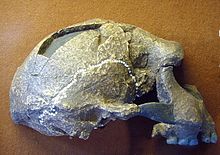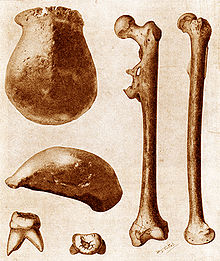Homo erectus
Homo erectus is an extinct species of the genus Homo. From the Pleistocene populations of Africa attributed to Homo erectus, Neanderthal man probably evolved in Europe and - parallel to but independent of him - anatomically modern humans (Homo sapiens) evolved in Africa. According to Richard Leakey, Homo erectus was "the first hominin species to use fire; the first to employ hunting as an essential element in securing its food supply; the first to walk like a modern human." However, the distinction of Homo erectus from other species in the genus Homo is disputed among experts - between so-called lumpers and splitters. Moreover, Homo erectus evolved - independently of each other - into Homo heidelbergensis and Neanderthal (in Eurasia) as well as Homo sapiens (in Africa) and presumably Homo floresiensis (in East Asia); see Fig. 10: "Dispersal and evolution of Homo erectus". An "extinction date" is therefore not datable.
The first fossils of Homo erectus were discovered in Asia from the 1890s onwards. For decades, this led paleoanthropologists to conclude that anatomically modern humans evolved in Asia from ape-like ancestors, even though Charles Darwin had already suspected in 1871 that humans evolved in Africa because their closest relatives - chimpanzees and gorillas - were native to that region. This assessment also prevented for two decades the recognition of the first African Australopithecus africanus find - the child of Taung recovered in 1924 - as belonging to the ancestral line of modern humans. This was recognized as a probable error only after very old hominin fossils discovered in Africa were placed at the base of the genus Homo as Homo habilis by Louis Leakey in April 1964.
Naming
The name of the genus Homo is derived from Latin homo [ˈhɔmoː], German 'Mensch'. The species name erectus is derived from Latin erigere ('to raise up'). Homo erectus thus means 'the erect man'.
The first three fossils, Trinil I to III, discovered by Eugène Dubois in 1891/92 and known as Java Man, had initially been named by Dubois as Anthropopithecus erectus ('erect man-ape'), derived from ancient Greek ἄνθρωπος anthropos, German 'man' and Greek. πίθηκος, Old Greek pronounced píthēkos ('monkey'). In 1894, Dubois changed the generic name to Pithecanthropus erectus ('erect ape-man') in a technical paper, describing the species as a transitional form that had led to modern humans. In giving this name, Dubois took up a suggestion that Ernst Haeckel had recommended in 1863, when he had described a hypothetical transitional form between man and ape and called it Pithecanthropus.
In 1944, Theodosius Dobzhansky published the paper On species and races of living and fossil man, in which he argued that there had been only a single, variant species of Hominini at any time. In 1950, Ernst Mayr, in a lecture at the Cold Spring Harbour Symposium on Quantitative Biology, supported Dobzhansky's assumptions and convinced paleoanthropologists to assign all presumed human ancestors discovered in the meantime to the genus Homo and in future to refrain from naming individual finds with a genus and species name; instead, such fossils should be named according to their origin (for example, Sterkfontein find instead of "Plesianthropus" for Mrs. Ples). This had the consequence that the fossils designated as Pithecanthropus erectus were also renamed again, that according to the international rules for zoological nomenclature the species name erectus was retained and that the three fossils discovered by Eugène Dubois are now the type specimens of Homo erectus.
First description
→ Main article: Java Man
Holotype of Homo erectus are three fossils recovered by Eugène Dubois on the Indonesian island of Java: a cranium discovered in October 1891 with a prominent, continuous transverse bulge of the frontal bone above the root of the nose ("over-eye bulge"), collection number Trinil II; a completely preserved femur (Trinil III) discovered in August 1892, similar in shape and structure to the femur of anatomically modern humans, which Dubois interpreted as an indication that its owner moved similarly upright to modern humans; and a large molar tooth (Trinil I) already discovered in August 1891.
However, the tooth and skullcap were initially interpreted by Dubois as a fossil of a non-hominin ape, because Dubois believed they were similar to recent chimpanzees. He therefore initially assigned the find to the new species Anthropopithecus erectus; Anthropopithecus was the generic name of chimpanzees at the time.
The three fossils discovered by Eugène Dubois were considered at the time to be the first finds of fossils of the Hominini outside Europe and at the same time the oldest discovered from this clade up to that time. Due to the fact that they were found at the edge of a former body of water, the dating of the bones is problematic; according to current knowledge, the skullcap is thought to be about one million years old. However, the skullcap has so few characteristic features that it cannot be reliably compared with other fossils. The assignment of the molar tooth to the genus Homo, on the other hand, is not considered certain today, and the femur is interpreted by some researchers as belonging to anatomically modern humans (Homo sapiens).
The first description in Dubois' publication Paleontologische onderzoekingen op Java is dated in the original to the year 1892, which is why the full name of the species is usually Homo erectus DUBOIS, 1892; if, however, the publication was not published until 1893, as occasionally claimed, the species would have to be named Homo erectus DUBOIS, 1893.

Mandible of Ternifine, first described as Atlanthropus mauritanicus.

Sangiran 17 = Pithecanthropus VIII = Homo erectus, discovered 1969 (copy)
.jpg)
Sangiran IV: Upper jaw with palate (original, 1.6 mya; Koenigswald Collection in the Senckenberg Natural History Museum)
.jpg)
Skullcap "Sangiran II", original. Koenigswald Collection in the Senckenberg Nature Museum. Note the over-eye bulge above the left eye.

The finds of Eugène Dubois: skullcap "Trinil II", molar tooth and femur bone
Questions and Answers
Q: What is Homo erectus?
A: Homo erectus is an extinct species of the genus Homo.
Q: Where were fossil remains found?
A: Fossil remains were found in Java in the 1890s and in China in 1921.
Q: Were all of the fossils lost during World War II?
A: Nearly all of them were lost during World War II, but there are casts that are considered to be reliable evidence.
Q: When was it believed that the first modern humans lived in Asia?
A: Early in the 20th century it was believed that the first modern humans lived in Asia.
Q: When did many fossil finds from East Africa show up?
A: During the 1950s and 1970s, many fossil finds from East Africa (Kenya) showed that the oldest hominins came from there.
Q: Where did these fossils come from?
A: These fossils came from East Africa (Kenya).
Q: What do these fossils indicate about where early hominins originated?
A: These fossils indicate that early hominins originated from East Africa (Kenya).
Search within the encyclopedia